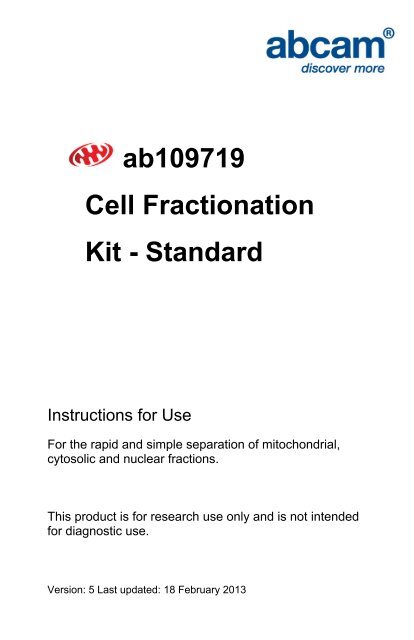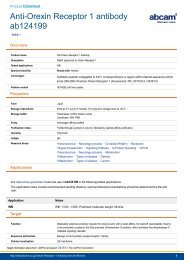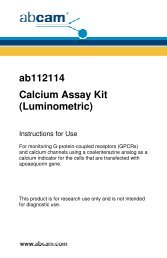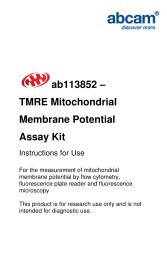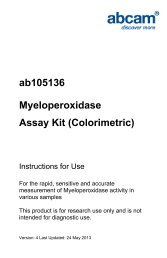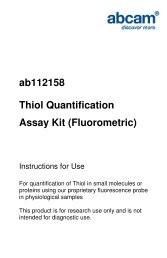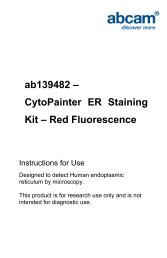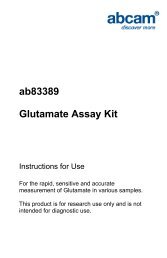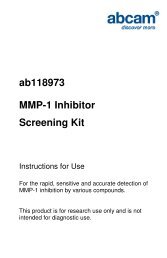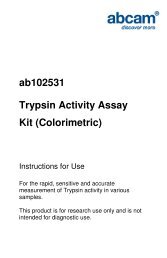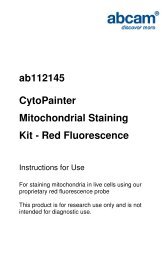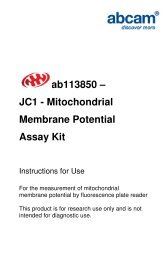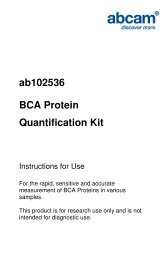ab109719 Cell Fractionation Kit - Standard - Abcam
ab109719 Cell Fractionation Kit - Standard - Abcam
ab109719 Cell Fractionation Kit - Standard - Abcam
You also want an ePaper? Increase the reach of your titles
YUMPU automatically turns print PDFs into web optimized ePapers that Google loves.
<strong>ab109719</strong><strong>Cell</strong> <strong>Fractionation</strong><strong>Kit</strong> - <strong>Standard</strong>Instructions for UseFor the rapid and simple separation of mitochondrial,cytosolic and nuclear fractions.This product is for research use only and is not intendedfor diagnostic use.Version: 5 Last updated: 18 February 2013
Table of Contents1. Introduction 22. Protocol Summary 53. <strong>Kit</strong> Contents 74. Storage and Handling 75. Additional Materials Required 76. Protocol 87. Protocol Notes 128. Data Analysis 151
1. Introduction<strong>ab109719</strong> (MS861) provides a method and reagents for a rapidpreparation of cytosolic, mitochondrial and nuclear fractions. The kitis based on sequential detergent-extraction of cytosolic andmitochondrial proteins without the need for mechanical disruption ofcells, and thus fractionates cells into cytosol-containing,mitochondria-containing and nuclei-containing fractions. Thesefractions are referred throughout the protocol as cytosolic,mitochondrial and nuclear fractions. With this kit sufficient samplematerial can be prepared for subsequent Western blot analysis, orfor analysis by microplate ELISA or dipstick assay.<strong>ab109719</strong> is designed to allow the measurement of any proteinswhich are differentially represented in the cytosol, mitochondria andnuclei, and is particularly applicable to studies of proteins thattranslocate between these three cellular compartments. As anexample, the use of the kit is described throughout this protocol inrelation to the following of cytochrome c release from themitochondria to the cytosol during apoptosis (see Figures 2, 3 and4), as this is perhaps the best known mitochondrial proteintranslocation event and it is an important component of apoptosisresearch. Similarly, the kit was successfully used to measure therelease of Smac/Diablo from the mitochondria to the cytosol and thetranslocation of Bax from cytosol to mitochondria during apoptosis as2
well as cleavage on nuclear poly (ADP-ribose) polymerase (PARP),see Figure 4.<strong>ab109719</strong> provides a rapid method to obtain cytosolic, mitochondrialand nuclear fractions, thus avoiding time consuming and inefficientcell disruption and differential centrifugation. The kit is based onsequential and selective extraction of cytosolic and mitochondrialproteins with proprietary detergents that allow sequential release ofcytosolic and mitochondrial proteins to the extracellular buffer. In thefirst step, the plasma membrane is selectively permeabilized withDetergent I. The cytosol-containing fraction is separated from theremainder of cells containing intact mitochondria and nuclei by asimple centrifugation step. In the second step, mitochondrial proteinsare then extracted with Detergent II and separated from the nucleicontainingfraction by a second centrifugation step.In control cells, mitochondrial intermembrane space proteinsincluding cytochrome c and Smac/Diablo remain in the mitochondrialfraction (Figures 1, 2, 3 and 4). However, if cytochrome c andSmac/Diablo are released from the mitochondrial intermembranespace into cytosol, as frequently occurs in apoptosis, the cytosoliccytochrome c and Smac/Diablo are found in the cytosolic fractionwith other cytosolic proteins (Figures 2, 3 and 4).The three distinct fractions generated can be analyzed by Westernblot or by ELISA microplate. For Western blot analysis, ApoTrackCytochrome c Apoptosis WB Cocktail is recommended3
(ab110415/MSA12) (typical results shown below), which contains anantibody against cytochrome c (ab110325/MSA06 Anti-cytochrome cmonoclonal antibody) plus antibodies against key mitochondrial andcytosolic markers. For the analysis of cytochrome c by microplateELISA assay, <strong>Abcam</strong>’s ab110172 (MSA41) Cytochrome c ProteinQuantity Microplate Assay <strong>Kit</strong> is recommended. These methodswere verified on HeLa cells, 143B osteosarcoma cells, SHSY5Yneuroblastoma cells, HepG2 cells and HdFN fibroblast cells treatedwith Staurosporine or Jurkat TIB 152 cells incubated withStaurosporine or anti-Fas antibody to undergo apoptosis. Theproportion of cytochrome c found in the cytosol-containing fractionsby this method correlated with the results of immunocytochemicalanalysis using <strong>Abcam</strong>’s ab110417/MSA07 ApoTrackCytochrome c Apoptosis for Immunocytochemistry (see Figure 5).4
2. Protocol SummaryGrow cells in two 100 mm dishes, approximately 2.5 x10.6 cells.Induce apoptosis in one dish by a desired methodHarvest cells by centrifugation at 300 x g for 5 minRe-suspend cells in 5 ml of 1X Buffer ADetermine cell count and total cell numberCentrifuge cells at 300 x g for 5 minRe-suspend cells in buffer A to 6.6 x 106 cells/mlPrepare Buffer B by 1000-fold dilution of Detergent I in Buffer ADilute the cell suspension with equal volume of Buffer BIncubate the tube with constant mixing for 7 min at RT Centrifuge the cell suspension at 5,000 x g for 1 min at 4°C Remove and save supernatant, save also pellet Centrifuge the supernatant at 10,000 x g for 1 min at 4°C Save the final supernatant; this is fraction CRe-suspend and combine both sequential pellets in Buffer A to theoriginal volume of cell suspension prior the addition of Buffer BPrepare Buffer C by 25-fold dilution of Detergent II in Buffer ADilute the suspension with equal volume of Buffer CIncubate the tube with constant mixing for 10 min at RT Centrifuge the cell suspension at 5,000 x g for 1 min at 4°C Remove and save supernatant, save also pellet Centrifuge the supernatant at 10,000 x g for 1 min at 4°C Save the final supernatant; this is fraction MRe-suspend and combine both sequential pellets in Buffer A tothe original volume of suspension after the addition of Buffer C;this is fraction N5
WESTERN BLOT ANALYSIS OF CYTOCHROME C RELEASEUSING ANTIBODY COCKTAIL ab110415/MSA12: Mix four volumes of sample with one volume of 5X SDS-PAGESample Buffer Vortex thoroughly Incubate 10 minutes at 37°C Load the samples on the gelIncubate the blocked membrane with provided antibody cocktaildiluted 250-fold in PBS containing 5% non-fat milk powder for 2hrs at RTCalculate the cytosolic cytochrome c in both untreated andtreated cells:Cyt c C (%) = 100 x Cyt c C/ (Cyt c C + Cyt c M + Cyt c N)Calculate the treatment-specific release of cytochrome cinto the cytosol:Cyt c C Released (%) = Cyt c C Treated (%) - Cyt c CUntreated (%)6
3. <strong>Kit</strong> ContentsSufficient materials are provided for fractionation of 1 x10 8 cells orfor preparation of 40 samples, each corresponding to one 100 mmplate at 2.5 x 10 6 cells/plate. 2X Buffer A: 175 mL Detergent I: 25 µL Detergent II: 1 mL 5X SDS Sample Buffer: 15 mL4. Storage and HandlingStore 2X Buffer A, Detergent II and 5X SDS Sample Buffer at -20°C,store Detergent I at -80°C.5. Additional Materials RequiredTube rotator for 1.5 ml tubes<strong>Cell</strong> counting device such as hematocytometer7
6. ProtocolNote: This protocol contains detailed steps for preparation ofsubcellular fractions and analysis by Western blot or microplateELISA. Be completely familiar with the protocol and protocolnotes before beginning the assay. Do not deviate from thespecified protocol steps or optimal results may not be obtained.1. Grow cells. Seed two 100 mm tissue culture plates at anequal density and grow them to semi-confluent density.6.2. Induce apoptosis. Incubate cells in one dish in thepresence of inducer of apoptosis at desired concentrationand for desired time. In parallel, incubate the uninducedcontrol cells in another dish.6.3. Equilibrate 2X Buffer A to room temperature (RT, seenote ii) and add equal volume of water to make 1X BufferA.6.4. Collect cells. For adherent cells, remove and savemedium. Detach cells by treatment with 8 ml of 0.25%Trypsin-EDTA and add the detached cells into the savedmedium. Rinse the plate with additional 4 ml of 0.25%Trypsin-EDTA and add the rinse to the pooled cells.Collect cells by centrifugation for 5 min at 300 x g at RT ina swinging bucket rotor centrifuge.8
6.5. 1X Buffer A wash. Re-suspend cell pellets in 5 ml of 1XBuffer A. Take a small aliquot (~25 μL) of un-inducedcontrol cells for counting. Note the volumes of both cellsuspensions. Collect cells by centrifugation for 5 min at300 x g at RT.6.6. Count cells. While centrifugation proceeds, count theuninduced cells using hematocytometer and determine thetotal cell number in the control sample.6.7. Prepare cell suspension in 1X Buffer A. Discardsupernatants and re-suspend control cell pellet in 1XBuffer A to 6.6 x 10 6 cells/ml. Re-suspend the induced cellpellet in the same volume of 1X Buffer A. See Note iii.6.8. Prepare Buffer B. To prepare Buffer B, dilute Detergent I1000-fold in 1X Buffer A. For example, to 5 ml of 1X BufferA add 5 μl of Detergent I. Mix well by pipetting. Prepareonly amount needed for immediate use.6.9. Cytosol Extraction. Transfer a volume of the cellsuspensions into a new set of tubes. Add the equalvolume of Buffer B to the cell suspensions. Mix bypipetting. Incubate samples for 7 minutes on a rotator atRT.9
6.10. Centrifugation. Centrifuge samples at 5,000 x g for 1 minat 4°C. Carefully remove all supernatants and transferthem to a new set of tubes. Save pellets on ice. Recentrifugethe supernatant fractions at 10,000 x g for1 min.6.11. Preparation of cytosolic fractions. Transfer the resultingsupernatants containing cytosolic proteins into a new setof tubes. These are the cytosolic fractions (C).6.12. Prepare suspensions of the cytoplasm-depleted “cells”(containing mitochondria and nuclei) in 1X Buffer A. Resuspendand combine the sequential cytoplasm-depleted“cell” pellets, generated in Steps 10 and 11, in 1X Buffer A.Use the same volume of 1X Buffer A as was used tosuspend the intact control cells, to 6.6 x 10 6 cells/m inStep 9 prior to addition of Buffer B.6.13. Prepare Buffer C. To prepare Buffer C, dilute Detergent II25-fold in 1X Buffer A. For example, to 4.8 m of 1X BufferA add 0.2 ml of Detergent II. Mix well by pipetting. Prepareonly amount needed for immediate use.6.14. Mitochondria Extraction. Transfer a volume of the cytosoldepletedsamples generated in Step 12 into a new set oftubes, for example 9/10 of the re-suspended sample. Addexactly the same volume of Buffer C to the suspensions.10
Mix by pipetting. Incubate samples for 10 minutes on arotator at RT.6.15. Centrifugation. Centrifuge samples at 5,000 x g for 1 minat 4°C. Carefully remove all supernatants and transferthem to a new set of tubes. Save pellets on ice. Recentrifugethe supernatant fractions at 10,000 x g for1 min.6.16. Preparation of mitochondrial fraction. Transfer theresulting supernatants containing mitochondrial proteinsinto a new set of tubes. These are the mitochondrialfractions (M).6.17. Preparation of nuclear fraction. Re-suspend and combinethe sequential cell pellets, generated in Steps 15 and 16,in 1X Buffer A to the original volume of suspensions afterthe addition of Buffer C in Step 14. These fractions containre-suspended cytosol- and mitochondria-depletedremainder of cells containing nuclei and thus represent thenuclear fractions (N).6.18. Analysis by ELISA. For analysis of fractions by <strong>Abcam</strong>’sCytochrome c Protein Quantity Microplate Assay <strong>Kit</strong>(ab110172/ MSA41), follow the provided protocol.11
Note: Analysis by SDS-PAGE/Western blotting. Mix fourvolumes of sample with one volume of 5X SDS-PAGE SampleBuffer. The samples prepared from nuclear fractions (N) maybecome very viscous due to the presence of DNA. To avoidpipetting errors it is important to shear the DNA. This is bestdone using a probe sonicator; alternatively the DNA may besheered by very vigorous vortexing for about two minutes.Incubate the samples containing SDS PAGE Sample Buffer for10 min in 60°C water bath and vortex again briefly. Loadsamples of equal volumes of fractions C, M and N side by sideonto gel immediately.6.19. Western Blotting. Proceed with Western Blot analysis.7. Protocol Notesi. <strong>Cell</strong> collection. Since cell detachment during apoptosis is acommon phenomenon, it is compulsory to collect, in thecase of adherent cells, any cells floating in the medium inaddition to the cells attached to the dish see Step 4.ii.2X Buffer A thawing. After 2X Buffer A is thawed or broughtto 1X with water, the formation of white precipitate is normal.To dissolve the precipitate, incubate the samples 10 min inhot water bath with occasional inversion.12
iii. Detergent I permeabilization. The appropriatepermeabilization conditions depend on ratio of Detergent I tothe total cellular mass, see Data Analysis section. Sincecells vary in their size, the recommended cell concentration(3.3 x 10 6 cells/ml) during the treatment with Detergent I wasdetermined to be optimal for 143B osteosarcoma cells, HeLacells, HepG2 cells, HdFN cells and SHSY5Y cells. To keepthe ratio of detergent to total cellular mass constant, smallcells, like Jurkat cells, need to be re-suspended to 20 x 10 6cells/ml at Step 7, to obtain 10 x10 6 cells/ml during thetreatment with Detergent I. The same rules apply toextraction of mitochondrial proteins by Detergent II.iv.For other cell types, we recommend to initially optimize theratio of Detergent I to the total cellular protein. Prepare atwo-fold dilution set of cell suspensions in 1X Buffer A. Toeach sample add equal volume of diluted detergent as inStep 9. Then follow the steps in the protocol. Determine thesample with the lowest ratio of detergent to cell number inwhich GAPDH signal is present in C fraction and absent inthe corresponding M fraction. Use this ratio to analyzetranslocation of proteins between mitochondria and cytosolin a drug-treated sample of this particular cell line.13
v. The cytosolic, mitochondrial and nuclear fractions prepared,respectively, in Steps 11, 16 and 17 may be flash-frozen andstored at -80°C.vi.vii.viii.Protein assay (optional). Save a small aliquot of cellsuspension from Step 5 for subsequent determination oftotal protein in the whole cell suspension. Subsequently,when fractions are analyzed, load fractions derived fromuntreated and treated cells in amounts proportional,respectively, to the equal amount of protein in the untreatedand treated whole cell suspension.If desired, mock-Detergent I treated samples can beprepared by dilution of cell suspension prepared in Step 7with equal volume of the 1X Buffer A. Similarly, mock-Detergent II treated samples can be prepared by dilution ofsuspension of cytosol-depleted remainder of cells preparedin Step 12 with equal volume of the 1X Buffer A.If desired, 1X Buffer A can be supplemented with proteaseinhibitors, such as Protease Inhibitor Cocktail to minimizenonspecific proteolysis during the fractionation.14
8. Data Analysis1. Control of fractionation. The complete permeabilization ofthe plasma membrane by Detergent I and thus release ofcytosolic proteins from the cells, as well as completeextraction of mitochondrial proteins by Detergent II and thusseparation of mitochondrial and nuclear compartments areprerequisite for assaying redistribution of cytochrome c, andothers intermembrane-space localized pro-apoptoticproteins, from mitochondrial intermembrane space intocytosol or nucleus. The ApoTrack Cytochrome cApoptosis WB Antibody Cocktail (ab110415/ MSA12) allowsmonitoring, in addition to cytochrome c, of glyceraldehyde-3-phosphate dehydrogenase (GAPDH) and pyruvatedehydrogenase E1 α,(PDH E1 α) a mitochondrial matrixprotein of 44 kDa, to verify internally the permeabilizationprocess. <strong>ab109719</strong> is optimized to deliver completeDetergent I-driven permeabilization of HeLa, 143B, HepG2,SHSY5Y, HepG2, HdFN and Jurkat cells. When these cellsare used, the great majority of GAPDH, a cytosolic protein ofabout 38 kDa, is present in the C fraction, while little or nosignal is present in the M fraction, indicating sufficientpermeabilization by Detergent I to release cytosolic proteinsout of the cells. In the untreated control cells, the greatmajority of cytochrome c, an intermembrane space protein of15
~13 kDa, is present in the M fraction indicating intactness ofmitochondrial outer membrane towards the Detergent I. Incells induced to undergo apoptosis, while cytochrome credistributes from fraction M to fraction C, the great majorityof PDH E1 α remains in the M fraction, indicating theintactness of the mitochondrial inner membrane. <strong>ab109719</strong>is also optimized to deliver complete Detergent II-drivenextraction of mitochondrial proteins, while preservingmajority of nuclear proteins in the detergent-resistant nuclearfraction. Thus in control HeLa or HepG2 cells the greatmajority of cytochrome c and PDH E1 α is present in the Mfraction while little or no signal of these proteins is present inthe N fraction. At the same time, the great majority ofnuclear markers PARP and transcriptional factor SP1 arefound in the nuclear fraction while little or no signal of theseproteins is present in the C and M fractions.2. General mitochondrial marker. The kit allows comparisonand normalization of the amounts of mitochondria amongdifferent cell types or treatments of cells by assaying for themitochondrial inner membrane protein, Complex V α (~55kDa).3. Determination of the distribution of a protein betweencytosolic, mitochondrial and nuclear fractions. Thedistribution of a protein between C, M and N fractions iscalculated as percentage of the protein present in a fraction16
out of the sum of the protein present in C, M and N fractions.For example, the determination of cytosolic cytochrome c isindicated by the formula below.Cytochrome c fraction C (%) = 100 x cytochrome c fraction C/(cytochrome c fraction C + cytochrome c fraction M + cytochrome cfraction N)If a drug or conditions change the distribution of a protein,the protein distribution before and after the treatment can becompared and protein translocation specific to the treatmentcan be calculated. For example, the release of cytochrome ccaused by a drug treatment is indicated by the formulabelow.Released Cytochrome c fraction C (%) = Cytochrome c fraction Cof treated cell (%) - Cytochrome c fraction C of untreated cells (%)17
Figure 1. Cytosolic (C), mitochondrial (M) and nuclear (N) fractionsof HepG2 cells were prepared as described in the Protocol.Fractions were analyzed by Western blotting using ab110415ApoTrack Cytochrome c Apoptosis WB Antibody Cocktail(MSA12) containing antibodies against mitochondrial matrix(pyruvate dehydrogenase subunit E1α, PDH E1α), mitochondrialinner membrane (F1-ATPase α), mitochondrial intermembranespace (cytochrome c) and cytosolic (glyceraldehyde-3-phosphatedehydrogenase, GAPDH) markers as well as with antibodiesagainst additional mitochondrial matrix (Hsp70) and nuclear (poly(ADP-ribose) polymerase, PARP and SP1) markers, followed byappropriate HRP-conjugated goat secondary antibodies and ECLdetection. Representative blots as well as the quantitative analysis,as described in Data Analysis, are shown.18
Figure 2. HeLa cells were treated for 4 hrs with 1 μMStaurosporine (STS) or were left untreated (CONTROL). Thecytosolic fraction (S) and mitochondria-containing reminder of thecells (P) were prepared by Detergent I extraction (“+”, 1X Buffer Acontaining Detergent I, as described in the Protocol), or by mockextraction(“-“, 1X Buffer A without Detergent I). The samplesderived from 12 μg of whole cells protein were analyzed byWestern blotting ab110415 ApoTrack Cytochrome c ApoptosisWB Antibody Cocktail (MSA12), an alkaline phosphataseconjugatedgoat anti-mouse secondary antibody, and APConjugate Substrate <strong>Kit</strong>. A representative blot as well as thequantitative analysis, as described in Data Analysis, is shown.19
Figure 3. Jurkat cells were treated for 4 hrs with 50 ng/ml Fasantibody (clone CH11) or 1 μM Staurosporine (STS) or were leftuntreated (CONTROL). HeLa cells and 143 B cells were treated,respectively, for 4 hrs and 5 hrs with 1 μM STS, or were leftuntreated (CONTROL). The cytosolic fraction (C) andmitochondria-containing reminder of the cells (M) were prepared asdescribed in the Protocol. The samples were analyzed by Westernblotting using ab110415 ApoTrack Cytochrome c Apoptosis WBAntibody Cocktail (MSA12), an alkaline phosphatase-conjugatedgoat anti-mouse secondary antibody and AP Conjugate Substrate<strong>Kit</strong>. Representative blots as well as the quantitative analysis, asdescribed in Data Analysis, are shown.20
Figure 4. HeLa cells were treated with 0, 125 or 250 nM Staurosporine.Cytosolic (C), mitochondrial (M) and nuclear (N) fractions were prepared asdescribed in the Protocol. Fractions were analyzed by Western blotting usingantibodies against Bax cytochrome c, Smac, Hsp70 (ab2799) and PARP(following with appropriate HRP-conjugated goat secondary antibodies and21
ECL detection. Quantitative analyses of representative blots, as described inData Anaylsis, are shown.Figure 5. Jurkat cells were treated for 4 hrs with 1 μM Fas antibody (cloneCH11) or 1 μM Staurosporine (STS) or were left untreated (CONTROL) andprocessed for immunocytochemistry using <strong>Abcam</strong>’s ApoTrackCytochrome c Apoptosis <strong>Kit</strong> (ab110417/MSA07) for Immunocytochemistry.Overlays of cytochrome c (in green) and Complex V-α (in red) staining areshown in left panels, cytochrome c only staining in middle panels andoverlays of Complex V-α and DAPI (in blue) staining in right panels.22
UK, EU and ROWEmail: technical@abcam.comTel: +44 (0)1223 696000www.abcam.comUS, Canada and Latin AmericaEmail: us.technical@abcam.comTel: 888-77-ABCAM (22226)www.abcam.comChina and Asia PacificEmail: hk.technical@abcam.comTel: 108008523689 ( 中 國 聯 通 )www.abcam.cnJapanEmail: technical@abcam.co.jpTel: +81-(0)3-6231-0940www.abcam.co.jp23Copyright © 2012 <strong>Abcam</strong>, All Rights Reserved. The <strong>Abcam</strong> logo is a registered trademark.All information / detail is correct at time of going to print.


